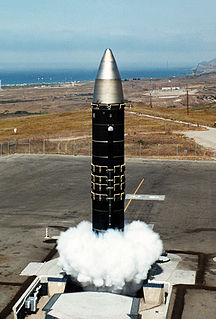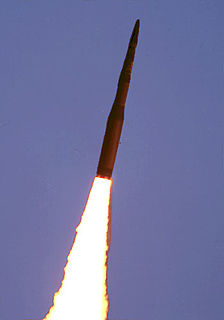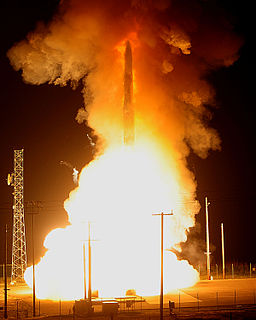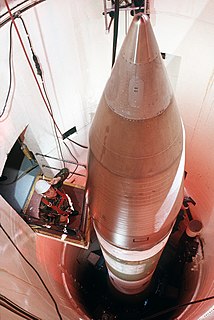
Vandenberg Air Force Base is a United States Air Force Base 9.2 miles (14.8 km) northwest of Lompoc, California. It is under the jurisdiction of the 30th Space Wing, Air Force Space Command (AFSPC).

The LGM-118 Peacekeeper, also known as the MX missile, was a land-based ICBM deployed by the United States starting in 1986. The Peacekeeper was a MIRV missile that could carry up to 10 re-entry vehicles, each armed with a 300-kiloton W87 warhead in a Mk.21 reentry vehicle (RV). A total of 50 missiles were deployed starting in 1986, after a long and contentious development program that traced its roots into the 1960s.

The 351st Operations Group is an inactive unit of the United States Air Force. Its last assignment was with the 351st Missile Wing at Whiteman Air Force Base, Missouri. It was inactivated on 31 July 1995.

A launch control center (LCC), in the United States, is the main control facility for intercontinental ballistic missiles (ICBMs). A launch control center monitors and controls missile launch facilities. From a launch control center, the missile combat crew can monitor the complex, launch the missile, or relax in the living quarters. The LCC is designed to provide maximum protection for the missile combat crew and equipment vital to missile launch. Missile silos are common across the midwestern United States, and over 450 missiles remain in US Air Force (USAF) service.

The 44th Missile Wing is an inactive United States Air Force unit. Its last assignment was with Twentieth Air Force, being assigned to Ellsworth AFB, South Dakota. It was inactivated on 4 July 1994.

The 564th Missile Squadron is an inactive United States Air Force unit. It was last assigned to the 341st Operations Group, stationed at Malmstrom Air Force Base, Montana.

The 741st Missile Squadron is a United States Air Force unit assigned to Minot Air Force Base, North Dakota. The squadron is equipped with the LGM-30G Minuteman III ICBM, with a mission of nuclear deterrence.

The mission of the 625th Strategic Operations Squadron (STOS) is to execute and support global strike through continuous, rapid, accurate and survivable nuclear operations. The 625th STOS has five flights that play different roles in this mission. The Latin motto of the 625th STOS is Si vis pacem para bellum, which means, "If you wish for peace, prepare for war."

The 68th Missile Squadron is an inactive United States Air Force unit. It was last assigned to the 44th Operations Group, stationed at Ellsworth AFB, South Dakota.

The Airborne Launch Control System (ALCS) provides a survivable launch capability for the United States Air Force's LGM-30G Minuteman III intercontinental ballistic missile (ICBM) force. The ALCS is operated by airborne missileers from Air Force Global Strike Command's (AFGSC) 625th Strategic Operations Squadron (STOS) and United States Strategic Command (USSTRATCOM). The weapon system is located onboard the United States Navy's E-6B Mercury, which serves as USSTRATCOM's "Looking Glass" Airborne Command Post (ABNCP). The ALCS crew is integrated into the ABNCP battle staff and is on alert around-the-clock.
This is a chronology of the LGM-30 Minuteman intercontinental ballistic missile, acquisition and operational.

Airborne Launch Control Centers provide a survivable launch capability for the United States Air Force's LGM-30 Minuteman Intercontinental Ballistic Missile (ICBM) force by utilizing the Airborne Launch Control System (ALCS) onboard which is operated by an airborne missileer crew. Historically, from 1967–1998, the ALCC mission was performed by United States Air Force Boeing EC-135 command post aircraft. This included EC-135A, EC-135C, EC-135G, and EC-135L aircraft.
A missile combat crew (MCC), is a team of highly trained specialists, often called Missileers, manning Intermediate Range and Intercontinental ballistic missile systems. In the United States, men and women, officially coded as Nuclear and Missile Operations Officers, of the United States Air Force, operate underground missile systems at launch control centers located throughout the country. There are also a select few missileers that have the chance to become part of a Missile Combat Crew-Airborne (MCC-A) operating the Airborne Launch Control System which provides a survivable launch capability for the Minuteman ICBM force. Crew size varied among the different missile systems, but the number was always greater than one, to abide by USSTRATCOM's Two-man rule for positive control of nuclear weapons.
Simulated Electronic Launch Minuteman (SELM) is a method used by the United States Air Force to verify the reliability of the LGM-30 Minuteman intercontinental ballistic missile. SELM replaces key components at the Launch Control Center to allow a physical "keyturn" by missile combat crew members. This test allows end-to-end verification in the ICBM launch process.
Simulated Electronic Launch Peacekeeper (SELP) was a method used by the United States Air Force to verify the reliability of the LGM-118A Peacekeeper intercontinental ballistic missile.

Warren AFB or redirects here. See Francis E. Warren at the link.













